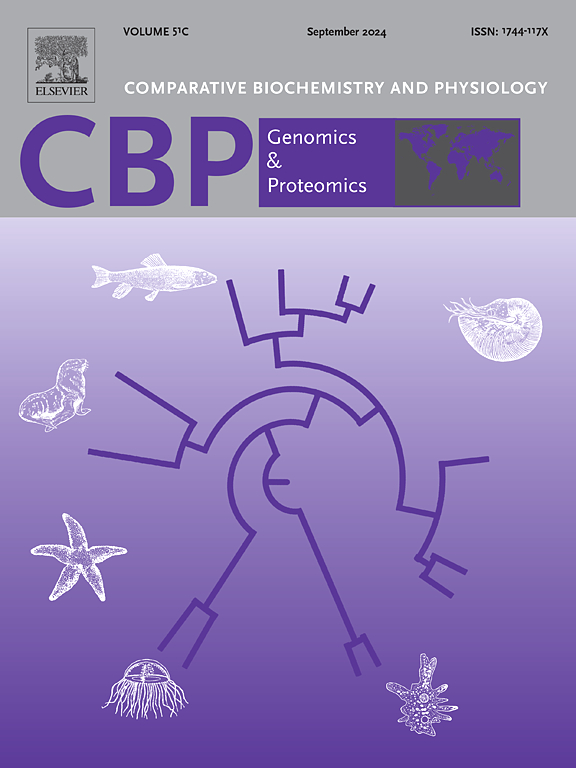Transcriptomic signatures associated with developmental transitions in the gill of lake sturgeon (Acipenser fulvescens)
IF 2.2
2区 生物学
Q4 BIOCHEMISTRY & MOLECULAR BIOLOGY
Comparative Biochemistry and Physiology D-Genomics & Proteomics
Pub Date : 2025-04-01
DOI:10.1016/j.cbd.2025.101505
引用次数: 0
Abstract
The developmental transition from the larval to juvenile stage, represents one of the highest periods of mortality for many species of fish. Thus, understanding the factors that may influence susceptibility to environmental stressors at this vulnerable stage is likely to be important for predicting responses to environmental change. Here, we compared gill mRNA transcript abundance during this critical developmental transition in fish from two geographically distinct populations of lake sturgeon (Acipenser fulvescens) that experience highly divergent thermal environments. Throughout the developmental transition from the larval to juvenile stage (30 to 60 days post-fertilization), the ‘colder’ northern population exhibited differential expression of approximately twice as many transcripts as compared to their ‘warmer’ southern counterparts. Transcriptional modifications that were conserved across both populations during the transition from the larva to juvenile stage were involved in histone methylation, protein binding, and apoptotic signaling associated with cell death and turnover. The northern population, specifically, had increased changes associated with GTPase signaling activation, cell surface proteins, mitochondrial and epithelial development which may have contributed to the larger magnitude of transcriptional change in this population, compared to their southern counterparts. Together these findings demonstrate the impacts of transcriptional shifts in the gill during development in lake sturgeon, as well as the potential for population-specific developmental processes.

湖鲟鳃发育转变的转录组学特征
从幼虫到幼鱼的发育过渡阶段是许多鱼类死亡率最高的时期之一。因此,了解在这一脆弱阶段可能影响环境压力易感性的因素对于预测对环境变化的反应可能是重要的。在这里,我们比较了两个地理上不同的湖鲟(Acipenser fulvescens)种群在这一关键发育转变期间的鳃mRNA转录丰度,这些种群经历了高度不同的热环境。在从幼虫到幼鱼阶段(受精后30至60天)的整个发育过程中,“寒冷”的北方种群表现出的转录本差异表达量大约是“温暖”的南方种群的两倍。在幼虫到幼鱼阶段的过渡过程中,两个种群中保守的转录修饰涉及组蛋白甲基化、蛋白质结合和与细胞死亡和周转相关的凋亡信号。特别是北方种群,与GTPase信号激活、细胞表面蛋白、线粒体和上皮发育相关的变化增加,这可能是导致该种群中转录变化幅度较大的原因,与南方种群相比。总之,这些发现证明了湖鲟发育过程中鳃转录变化的影响,以及种群特异性发育过程的潜力。
本文章由计算机程序翻译,如有差异,请以英文原文为准。
求助全文
约1分钟内获得全文
求助全文
来源期刊
CiteScore
5.10
自引率
3.30%
发文量
69
审稿时长
33 days
期刊介绍:
Comparative Biochemistry & Physiology (CBP) publishes papers in comparative, environmental and evolutionary physiology.
Part D: Genomics and Proteomics (CBPD), focuses on “omics” approaches to physiology, including comparative and functional genomics, metagenomics, transcriptomics, proteomics, metabolomics, and lipidomics. Most studies employ “omics” and/or system biology to test specific hypotheses about molecular and biochemical mechanisms underlying physiological responses to the environment. We encourage papers that address fundamental questions in comparative physiology and biochemistry rather than studies with a focus that is purely technical, methodological or descriptive in nature.

 求助内容:
求助内容: 应助结果提醒方式:
应助结果提醒方式:


